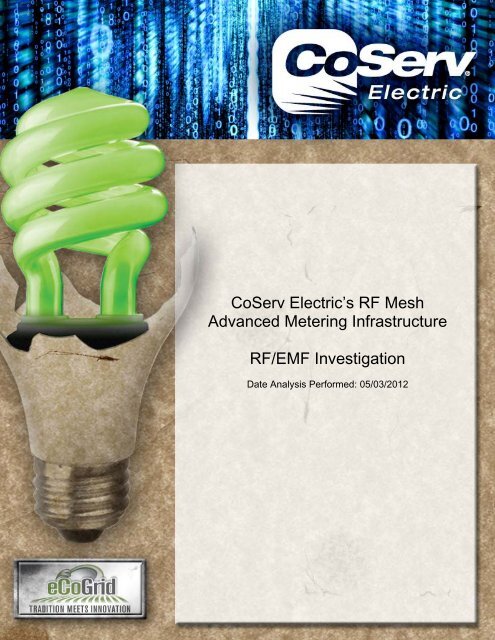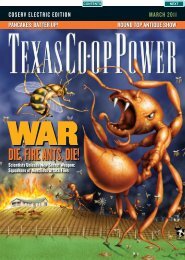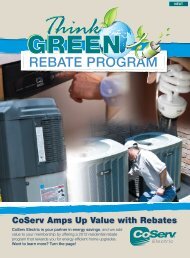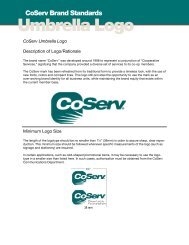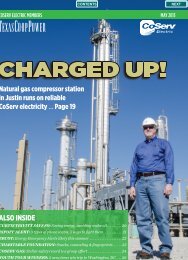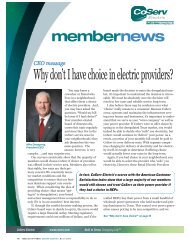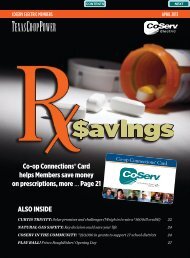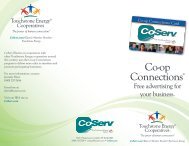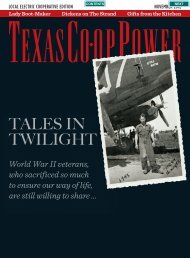Detailed Radio Frequency - CoServ.com
Detailed Radio Frequency - CoServ.com
Detailed Radio Frequency - CoServ.com
Create successful ePaper yourself
Turn your PDF publications into a flip-book with our unique Google optimized e-Paper software.
<strong>CoServ</strong> Electric’s RF Mesh<br />
Advanced Metering Infrastructure<br />
RF/EMF Investigation<br />
Date Analysis Performed: 05/03/2012
Introduction<br />
<strong>CoServ</strong> Electric is a not-for-profit electric distribution cooperative and, as such, is regulated and directed<br />
by its Board of Directors (elected representatives who oversee the operations of the cooperative). These<br />
Directors hold a fiduciary responsibility to represent the interests of the Member - our consumers.<br />
Surveys show that these Member consumers (made up of residents and business owners across Collin,<br />
Denton, Tarrant, Grayson, Wise, and Cooke counties) are “tech savvy,” and look to <strong>CoServ</strong> to provide<br />
them with resources to save energy and money. In order to meet our Members’ expectations, our<br />
<strong>com</strong>pany must innovate and empower our Members with advanced technology to manage energy use.<br />
After significant research and an extensive application process, <strong>CoServ</strong> Electric’s Board approved a $17.2<br />
million Department of Energy Smart Grid Investment Grant in March 2010 to support the installation of<br />
the AMI project – an electric distribution technology initiative called the <strong>CoServ</strong> eCoGrid. In September<br />
2010, <strong>CoServ</strong> announced its selection of Landis+Gyr’s Gridstream RF technology to provide the advanced<br />
metering and distribution technology supporting the initiative. The system consists of a robust two-way<br />
<strong>com</strong>munications network (a wireless system supported by collectors and routers), advanced metering,<br />
distribution automation and personal energy management applications. Once fully deployed, the system<br />
will provide operational efficiencies that will reduce costs, streamline operations, improve system<br />
reliability, and offer Members new technology to monitor and reduce energy usage in their homes and<br />
businesses.<br />
<strong>CoServ</strong> has begun work on full system deployment, with project <strong>com</strong>pletion scheduled for April 2013. In<br />
that timeframe, all <strong>CoServ</strong> Members will have an advanced meter installed on, or at, their premise.<br />
<strong>Radio</strong> Frequencies<br />
<strong>Radio</strong> <strong>Frequency</strong> (RF) is produced by all transmitting devices which are <strong>com</strong>mon and in widespread use<br />
today. Examples of RF producers include radio broadcast stations, television stations, satellites<br />
transmitting services to earth, and even our sun. A normal consequence of RF is the production of an<br />
electromagnetic field or EMF.<br />
There are three factors for consideration of human exposure to RF 1 :<br />
1. Signal Strength<br />
2. Distance from the transmitting device<br />
3. How often the device transmits<br />
1 An Investigation of <strong>Radio</strong>frequency Fields Associated with the Itron Smart Meter, EPRI Technical Report 1021126, December<br />
2010, www.epri.<strong>com</strong> page 3.
Establishment of Safe Exposure Levels<br />
The Federal Communications Commission (FCC) provides the regulatory standards associated with<br />
exposure to RF/EMF. IEEE standard C95.1-1191 (ANSI/IEEE C95.1-1992) specifies safe levels of human<br />
exposure to radio frequency electromagnetic fields. The FCC has adopted the IEEE standard as the<br />
foundation for regulations related to human exposure limits and has been presented as a regulation in<br />
47CFR1.1310. The source document for human EMF exposure limits is now known as Office of<br />
Engineering & Technology (OET) Bulletin 65. There have been no changes to the exposure limits.<br />
OET Bulletin 65 refers to two safety limits which are Occupational/controlled limits and General<br />
population/uncontrolled limits. General population/uncontrolled limits will apply to situations which<br />
the general public may be exposed, but not fully aware of, their potential exposure or cannot exercise<br />
any control over their exposure. An example of this is a radio transmission tower which is exposing<br />
people to EMFs. This definition is the basis for <strong>com</strong>parisons of regulatory exposure limits to actual field<br />
readings taken by <strong>CoServ</strong> personnel. This is the category <strong>CoServ</strong>’s AMI RF Mesh network, including the<br />
AMI meter, falls under.<br />
OET Bulletin 65 defines the limits for Maximum Permissible Exposure as values of electric and magnetic<br />
field strength and power density for transmitters. For equipment that operates intermittently or in a<br />
“burst” mode – such as the AMI meter- OET Bulletin 65 defines the period over which exposure can be<br />
averaged and will represent a similar level of exposure as a maximum continuous exposure. This data<br />
produces a minimum safe distance to the source.<br />
The devices on a Member’s residence or business that uses the RF Mesh network are the radio module<br />
inside of the meter and the devices used for a Home Area Network (HAN). Table 1 2 below provides the<br />
equivalent minimum safe distance in an uncontrolled environment for the mentioned RF sources.<br />
RF Mesh Device<br />
Residential and C&I modules<br />
Home Area Network <strong>Radio</strong><br />
Home Area Network Device<br />
Table 1<br />
Equivalent MSD – Uncontrolled Environment<br />
0.63 inches<br />
0.05 inches<br />
0.05 inches<br />
As a worse case, this table indicates a person will need to remain 0.63 inches from the radio device in an<br />
AMI meter for an exposure limit to be greater than allowed. The distance between the radio and the<br />
glass covering the meter is greater than this; so a hazardous exposure is not possible if the normal mode<br />
and construction of the system and meter remain intact.<br />
Another measurement to be considered with a RF/EMF investigation is the power density of the<br />
transmitting device. For this investigation, the RF Mesh devices remain the same. Table 2 3 provides<br />
information related to power density in milliwatts per square centimeter (mW/cm 2 ).<br />
2 Landis + Gyr, “Acceptable Exposure Limits to Gridstream RF Devices”, page 6.<br />
3 Ibid.
RF Mesh Device<br />
Max FCC<br />
Permissible<br />
Exposure<br />
F[MHz]/1500<br />
Exposure @ 1<br />
foot from<br />
source<br />
(Continuous<br />
Transmission)<br />
Percent of<br />
FCC<br />
Exposure<br />
Limit<br />
Exposure at 1<br />
meter (3.28<br />
feet) from<br />
source<br />
Continuous<br />
Transmission)<br />
Percent of<br />
FCC<br />
Exposure<br />
Limit<br />
Residential and C&I Endpoints 0.6 0.3707 61.78% 0.03 5.6%<br />
HAN – Endpoint HAN <strong>Radio</strong> 1.6 0.2852 17.83% 0.03 1.6%<br />
Table 2<br />
Review of this information shows that, under normal exposure conditions, the exposure level for the RF<br />
Mesh equipment, including the meter, will be below FCC requirements.
Field Analysis<br />
Date Analysis Performed: 05/03/2012<br />
Readings Performed by: Kevin Maynard – Communications Foreman, <strong>CoServ</strong> Electric<br />
Device Used: NARDA SRM-3006<br />
Serial Number: H-0024<br />
Calibration Date: 03/27/2012<br />
The device used to test EMF is a NARDA SRM-3006 Selective Radiation Meter. It is used to measure RF<br />
and EMF levels and is equipped with a spectrum analyzer. The device allows for the determination of<br />
EMF and RF strength levels by providing ambient and specific frequencies down to individual<br />
<strong>com</strong>ponents for detailed analysis. The device allows for ability to calculate the maximum permissible<br />
exposure for a given frequency. It is equipped with a three –axis (iso-tropic) E-field antenna which is a<br />
non-directional electrical field measurement antenna.<br />
The SRM-3006 captures the signal(s) from the AMI meter and will display in real time the actual pulse of<br />
the transmitter and the maximum peak of the transmit packet from the AMI meter. The SRM-3006<br />
samples RF signals in the 902-928 MHz spectrum for approximately 5000 to 6000 cycles with a sweep<br />
time of 39 milliseconds at each distance. This cycle duration is adequate to capture transmissions from<br />
the AMI meter as it <strong>com</strong>municates to the RF Mesh network. The SRM-3006 is programmed to show the<br />
‘FCC General Public Access’ regulatory limit which is displayed as mW/cm 2 , mW/m 2 , and as a<br />
percentage of the FCC limit. Additional programming of the SRM-3006 includes the limits of several<br />
other standards and regulatory rules.<br />
The frequencies used by the radio module and the HAN device were not investigated as separate<br />
frequencies. Therefore, captured power densities will be accumulative of the devices and conclusions<br />
will be based on a worst case scenario.<br />
Actions<br />
Using the SRM-3006, outdoor readings were taken at one (1) foot and three (3) feet distances from the<br />
meter for 5 minutes at each distance. Readings were also taken inside of residence at approximately<br />
two (2) feet directly behind the meter.<br />
Once all of the readings had been <strong>com</strong>pleted inside of residence, another reading was taken inside the<br />
residence to capture all ambient frequencies which existed in the residence.<br />
Readings<br />
Location: Outside, 1 foot from meter
Figure 1 - Power Density<br />
Findings: Reading is at 274.6 mW/m 2 . Conversion to mW/cm 2 – divide by 10,000 = .02746 mW/cm 2 .<br />
Figure 2 - FCC Exposure Percentage<br />
Findings: Reading is 4.497% of FCC Exposure percentage.<br />
Location: Outside, 3 foot from meter
Figure 3 - Power Density<br />
Findings: Reading is at 1.065 µW/cm 2 . Conversion to mW/cm 2 – divide by 10 = 0.1065 mW/cm 2 .<br />
Figure 4 - FCC Exposure Percentage<br />
Findings: Reading is .202% of FCC Exposure percentage.<br />
Location: Inside, 2 feet from meter
Figure 5 - Power Density<br />
Findings: Reading is at 2.211 mW/m 2 . Conversion to mW/cm 2 – divide by 10,000 = .0002211 mW/cm 2 .<br />
Figure 6 - FCC Exposure Percentage<br />
Findings: Reading is .035% of FCC Exposure percentage.<br />
Location: Inside – Ambient frequencies
Findings: No remarkable findings<br />
Comments<br />
Members may be able to find a relatively inexpensive meter that claims it provides EMF readings.<br />
These meters are typically a wide band product which covers a frequency range of 1MHz to 8GHz and<br />
are equipped with a simple omni-directional antenna. It should be noted, these devices are not<br />
designed to be frequency specific or a true EMF measurement. These meters will measure fields from<br />
all sources that transmit from 1MHz to 8GHz and typically do not measure using E-Field or H-Field. E-
Field is the electrical <strong>com</strong>ponent and the H-Field is the magnetic <strong>com</strong>ponent of an EMF field.<br />
Conclusions<br />
Comparison of FCC Guidelines to the manufacturer’s meter specification and the field investigation is<br />
shown in the table below.<br />
Location/Distance<br />
FCC Permissible<br />
Power Density<br />
(mW/cm 2 )<br />
Manufacturer<br />
Spec Power<br />
Density<br />
(mW/cm 2 )<br />
Calculated<br />
Percentage<br />
Power Density<br />
Measured<br />
(mW/cm 2 )<br />
Calculated<br />
Percentage to<br />
FCC<br />
Recorded<br />
Percentage to<br />
FCC<br />
Outside/1 foot 0.6000 0.3707 61.7833% 0.2746 4.5800% 4.4970%<br />
Outside/3 foot 0.6000 0.3707 61.7833% 0.1065 0.1775% 0.2020%<br />
Inside/2 foot 0.6000 0.3707 61.7833% 0.0002211 0.0369% 0.0350%<br />
The RF/EMF emissions from the installed AMI meter at this residence falls well under the requirements<br />
of the FCC as defined in OET Bulletin 65. Additionally, the values recorded were under the specifications<br />
provided by the vendor of the equipment.<br />
An examination of the ambient frequencies in the residence show there are exposures which are<br />
naturally occurring and greater in power density than what is contributed by the AMI meter.<br />
For more information on AMI and the RF impacts, please refer to<br />
EPRI <strong>Radio</strong>-<strong>Frequency</strong> Exposure Levels from Smart Meters: A Case Study of One Model<br />
<strong>CoServ</strong>.<strong>com</strong> FAQ


